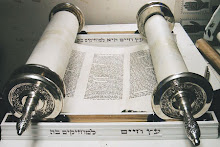The earliest Hebrew script was derived from a Phoenician script. The modern Hebrew script was developed from a script known as Proto-Hebrew/Early Aramaic. The earliest known writing in Hebrew dates from the 11th century BC.
Hebrew is a member of the Canaanite group of Semitic languages. It was the language of the early Jews, but from 586 BC it started to be replaced by Aramaic. By 70 AD use of Hebrew as an everyday language had largely ceased, but it continued to be used for literary and religious functions, as well as a lingua franca among Jews from different countries.
During the mid-19th century the first efforts were made to revive Hebrew as a everyday language. One man who played a major role in these efforts was Eliezer Ben Yehuda (1858-1922), who was the first to make exclusive use of Hebrew in his home, and encouraged the use of Hebrew among others, as well as its use in schools.
Today Hebrew is spoken by some 5 million people in Israel, where it is an official language along with Arabic. and a further 2 to 3 million people speak the language in Argentina, Australia, Brazil, Canada, France, Germany, Palestinian West Bank and Gaza, Panama, the UK and USA.
Notable features
- Type of writing system: abjad
- Direction of writing: right to left in horizontal lines.
- Number of letters: 22 consonants, plus final letters and diacritics
- Used to write: Hebrew, Judeo-Arabic, Ladino, Yiddish and many other Jewish languages.
- Some letters (kaf, mem, nun, fe and tzadi) have a final form (sofit), which is used when they appear at the end of a word.
- There are no separate numerals in Hebrew, instead standard western numerals (1, 2, 3, etc) are used.
- Long vowels can be indicated by the letters alef, vav, and yod. Short vowels are not usually marked, except in the Bible, poetry and books for children and foreign learners.
The Hebrew script
Modern Israeli pronunciation
Notes
- het is officially pronounced [ħ], but many people pronounce it [x]
- ʻayin is officially pronounced [ʕ], but many people pronounce it [ʔ]
Download
Download a Hebrew alphabet chart in Word or PDF format
Virtual Hebrew Keyboard
From: http://www.hebrew-keyboard.com/integrate/
Hebrew vowel points / Nikkud (נִקּוּד טְבֶרְיָנִי)
The first row of IPA transcriptions is the Modern Israeli Hebrew pronunciation,
the second row is the Medieval/Tiberian pronunciation.
Modern Cursive Hebrew script
Rashi
The Rashi style is used mainly to write commentaries on texts. It is named after Rabbi Shlomo Yitzchaki (1040-1105 AD) a.k.a. Rashi, one of the greatest medieval Jewish scholars and bible commentators. Rashi did not use the Rashi sytle to write his commentaries but it is named in honour of him.
Sample texts in Hebrew
Without vowels
With vowels
Cursive script
Listen to a recording of this text by גל ויסברג (Gal Weisberg)
Transliteration
Kol benei ha'adam noldu benei xorin veshavim be'erkam uvizxuyoteihem. Kulam xonenu batevuna uvematspun, lefixax xova 'aleihem linhog ish bere'ehu beruax shel axava.
Translation
All human beings are born free and equal in dignity and rights. They are endowed with reason and conscience and should act towards one another in a spirit of brotherhood.
(Article 1 of the Universal Declaration of Human Rights)
Corrections and text samples provided by Tal Barnea.
Hebrew Translation
Our Price:$10.00
Tower of Babel in Hebrew | Useful phrases in Hebrew
Hebrew language learning materials
Links
Information about the Hebrew language and alphabet
http://en.wikipedia.org/wiki/Hebrew_language
http://judaism.about.com/od/hebre1/Hebrew.htm
http://www.jewishvirtuallibrary.org/jsource/judaica/ejud_0002_0008_0_08629.html
Hebrew language courses
http://www.hebrewresources.com/onlineclass.html
http://www.hebrewcollege.edu/online
http://www.zigzagworld.com/hebrewforme
http://www.hebraico.pro.br (em português)
http://www.shalom.50megs.com
http://foundationstone.com.au
http://www.learn-hebrew.co.il
http://www.hebrewpodcasts.com
Learn Hebrew with dictionaries, online courses and easy Hebrew magazines
Free Hebrew fonts
http://www.wazu.jp/gallery/Fonts_Hebrew.html
http://oketz.com/fonts/
ALPHABETUM - a Unicode font specifically designed for ancient scripts, including classical & medieval Latin, ancient Greek, Etruscan, Oscan, Umbrian, Faliscan, Messapic, Picene, Iberian, Celtiberian, Gothic, Runic, Old & Middle English, Hebrew, Sanskrit, Old Nordic, Ogham, Kharosthi, Glagolitic, Old Cyrillic, Phoenician, Avestan, Ugaritic, Linear B, Anatolian scripts, Coptic, Cypriot, Brahmi, Old Persian cuneiform:http://guindo.pntic.mec.es/~jmag0042/alphabet.html
Semitic languages
Akkadian, Amharic, Arabic, Argobba, Canaanite, Chaha, Ge'ez,Hadhramautic, Hebrew, Himyaritic, Maltese, Mandaic, Nabataean,Phoenician, Qatabanic, Redjang, Sabaean, Sabaic, Silt'e, Syriac,Tigrinya, Ugaritic,
Other languages written with the Hebrew script
Bukhori, Hebrew, Judeo-Arabic, Ladino, Yiddish
Consonant alphabets (Abjads)
Ancient Berber, Arabic, Hebrew, Mandaic, Manichaean, Middle Persian, Nabataean,Parthian, Phoenician, Paleo-Hebrew, Proto-Sinaitic / Proto-Canaanite, Psalter, Punic,Sabaean, Samaritan, Sogdian, South Arabian, Syriac, Tifinagh, Ugaritic
If you want to pass ccna voice exam with highest score then make use of mcts braindumps in combination to 640-863 practice test and get desired results on first attempt guaranteed.

Nenhum comentário:
Postar um comentário